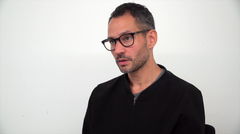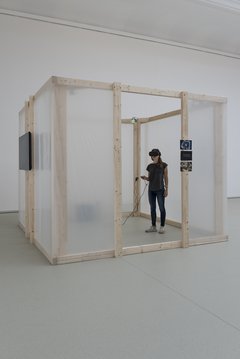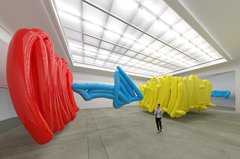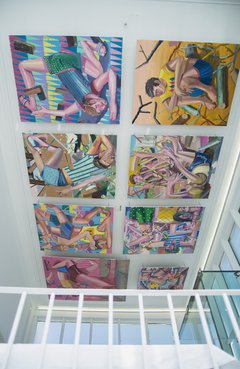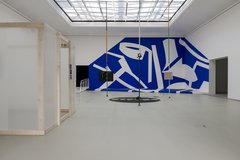A walk through our current exhibition "Artificial Paradise? Immersion in Space and Time"
On View: Artificial Paradise? Immersion in Space and Time
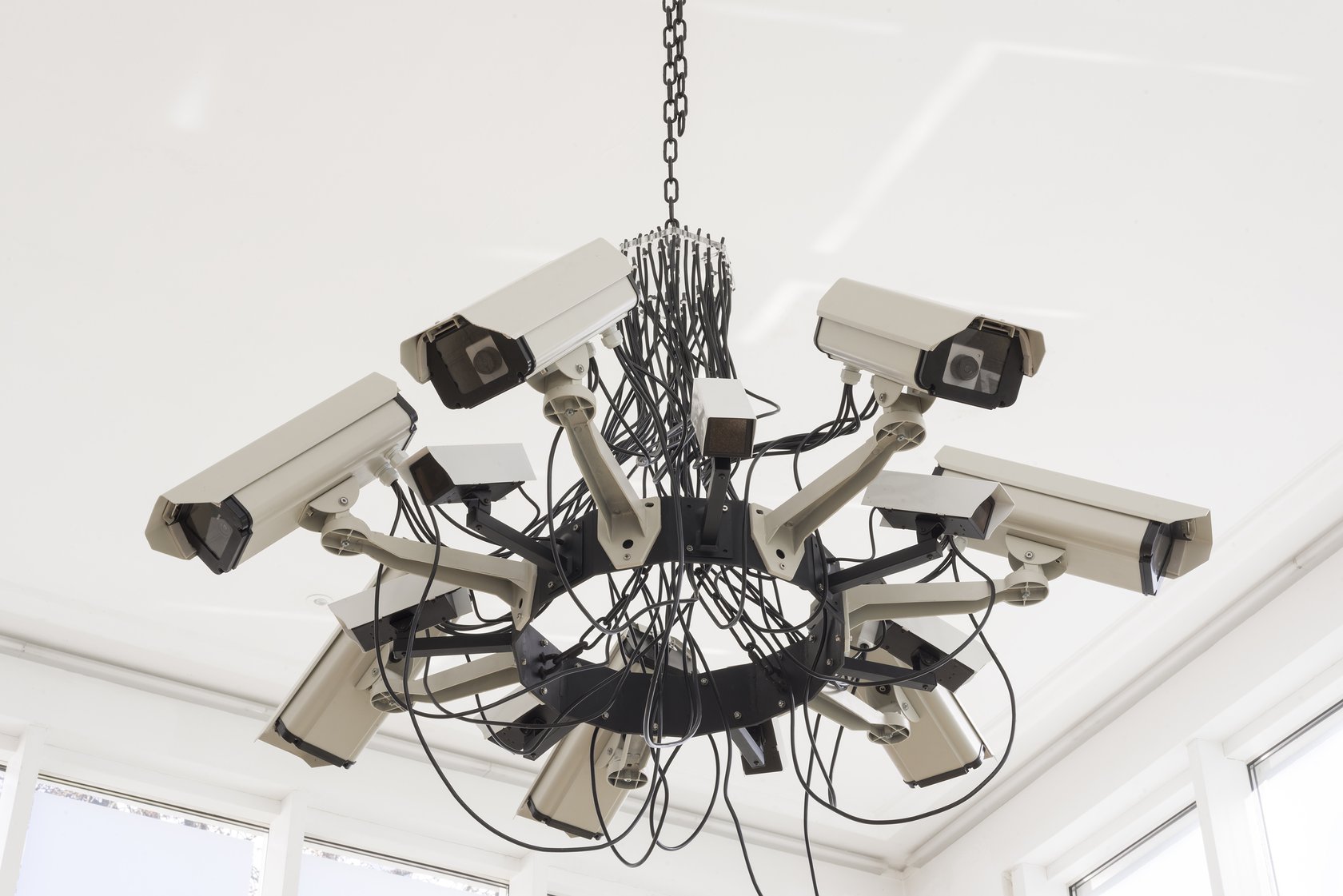
Addie Wagenknecht, Asymmetric Love, 2013
Steel, surveillance cameras, DSL-Internet cables, height: 99 cm, diameter: 150 cm Courtesy the artist and bitforms gallery, New York
The artistic works of Addie Wagenknecht (*1981 Portland, lives in New York and Innsbruck) deal with the conscious as well as the uncon scious impact of media technology on everyday life. Wagenknecht, who graduated from the Interactive Telecommunications Program at New York University, is especially interested in the independent life of technical appliances outside controlled energy supplies and stable data networks. In 2014, she founded the collective group Deep Lab, the members of which are bringing together fields such as privacy, se curity, surveillance, code, hacking, art, research, and theory. By arranging surveillance cameras in the style of a Baroque chandelier for her work Asymmetric Love (2013), the artist reflects on the pros and cons of technological networks: while the extensively available digital infrastruc ture appears to facilitate an allegedly free exchange of information, it is precisely its control mechanisms which disclose the power structures of the interconnected world.
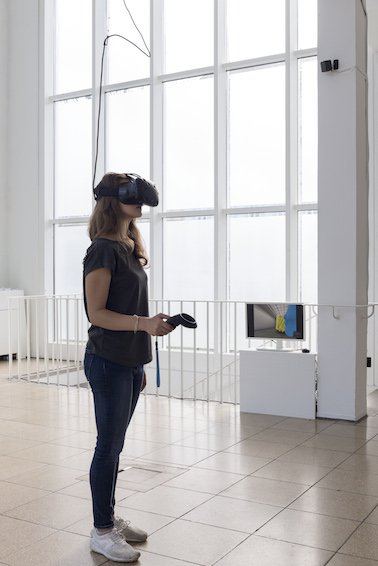
Manuel Roßner, Du musst dein Leben ändern (You Must Change Your Life), 2018
HTC Vive VR, VR PC, dimensions variable Commissioned by Künstlerhaus, Halle für Kunst & Medien Courtesy the artist
In 2012, the German artist and curator Manuel Roßner (*1989 Heilbronn, lives in Berlin) founded the Float Gallery to expand the classical exhibition space by a digital space. In his artistic practice, Roßner is concerned with the question of how spatial perception changes in virtual reality, furthermore, he discusses the impact of artificial intelligence on everyday life. In his works, he alludes repeatedly to the disturbing aspects that technological developments could entail. By way of the virtual reality installation, Du musst dein Leben ändern (2018), Roßner gives diffuse instructions that relate to the architecture of the Künstlerhaus. Hence, the digital objects that oscillate between drawing and sculpture, and move freely through the virtual space, can serve as obstacles as well as pointers to a change of direction. Their intent, however, remains unclear. The title of the work refers to the last line of Rainer Maria Rilke’s well-known poem Archaïscher Torso Apollos that was written in Paris in 1908. Its creation was influenced by Rodin’s sculptural work: In the sonnet, the confrontation with the perfection of an Apollonian torso leads to a call for improvement, respectively for the recreation of one’s life.
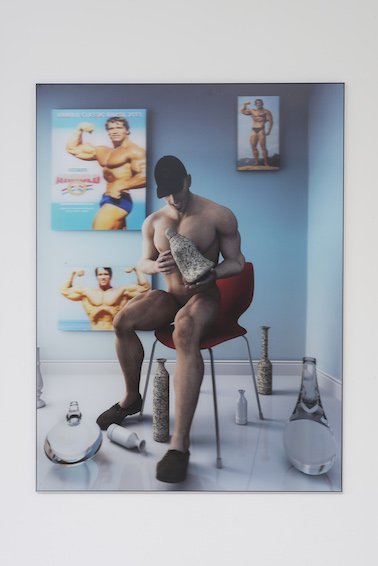
Olga Fedorova, Body Positive, 2018
Lenticular print, 121 x 91 cm / Courtesy the artist and Annka Kultys Gallery, London
Using three-dimensional digital rendering software, Olga Fedorova (*1980 Moscow, lives in Brussels) creates aseptic spaces and landscapes as settings for the—at times absurd—interactions of digitally generated creatures. The female figures in Fedorova’s works feature a stereotypical overemphasis on their sexuality, still they are mostly integrated into a domestic setting. Body Positive (2018), however, establishes the tension between clichéd ideas of masculinity and current approaches to technological optimization of humans in a humorous manner. By presenting her digital imagery as lenticular prints, Fedorova evokes the illusion of three-dimensionality. In order to create these prints, also known as flip images, 74 image files, with only small differences between each image and the next, are compiled onto ridged, overlapping plates. Changing the angle at which the image is viewed leads thus to a change of the spatial representation. In her works, Fedorova utilizes an anachronistic technique of optical illusion, in order to present scena rios of potential future worlds.
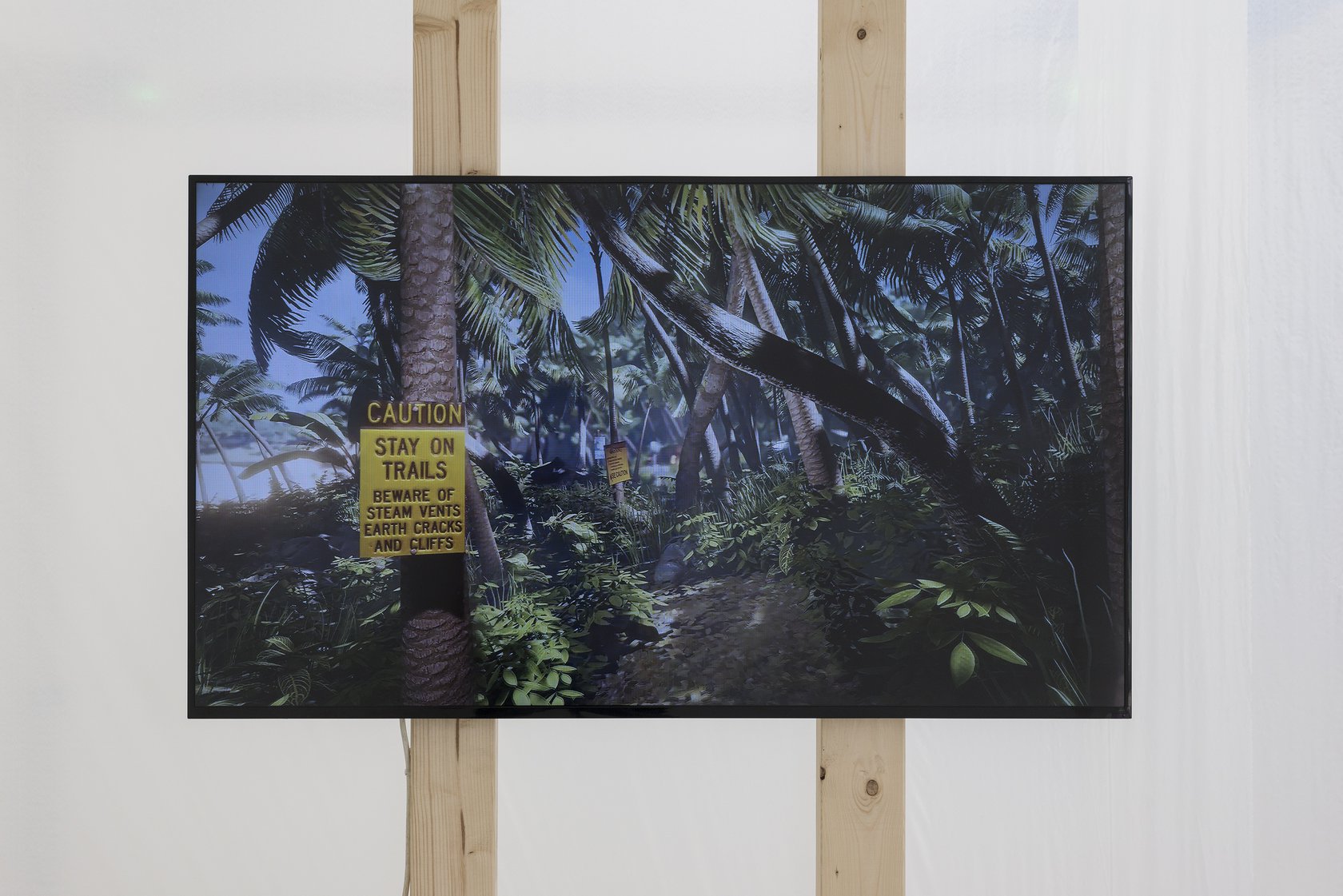
Jakob Kudsk Steensen, Primal Tourism, 2016
Wood, plastic sheeting, postcards, lamps, 48“ LCD monitor, Oculus Rift VR, VR PC, 250 x 300 x 300 cm / Courtesy the artist / Thanks to Danish Arts Council, Copenhagen
The interplay of imagination, technology, and ecology is the focus of Jakob Kudsk Steensen’s (*1987 Copenhagen, lives in New York) artistic practice. For his elaborate works, he researches extensively, compiles a diverse range of information material, and occasionally goes on longer field trips. Subsequently, Steensen creates his artificial worlds using a 3D-scanner, photogrammetry, information gathered from satellite recordings, and game developing software. For his VR-installation Primal Tourism (2016), the artist built a true to scale virtual version of the atoll Bora Bora in French Polynesia. The information used was taken from scientific studies of the ecosystem of the island on the one hand, and, for instance, from photographs by tourists that were shared on the social news aggregation Reddit, and drawings made by the adventurers of the Dutch East India Company on the other. Today the former “place of longing” Bora Bora is one of the world’s most exclusive and expensive travel destinations.
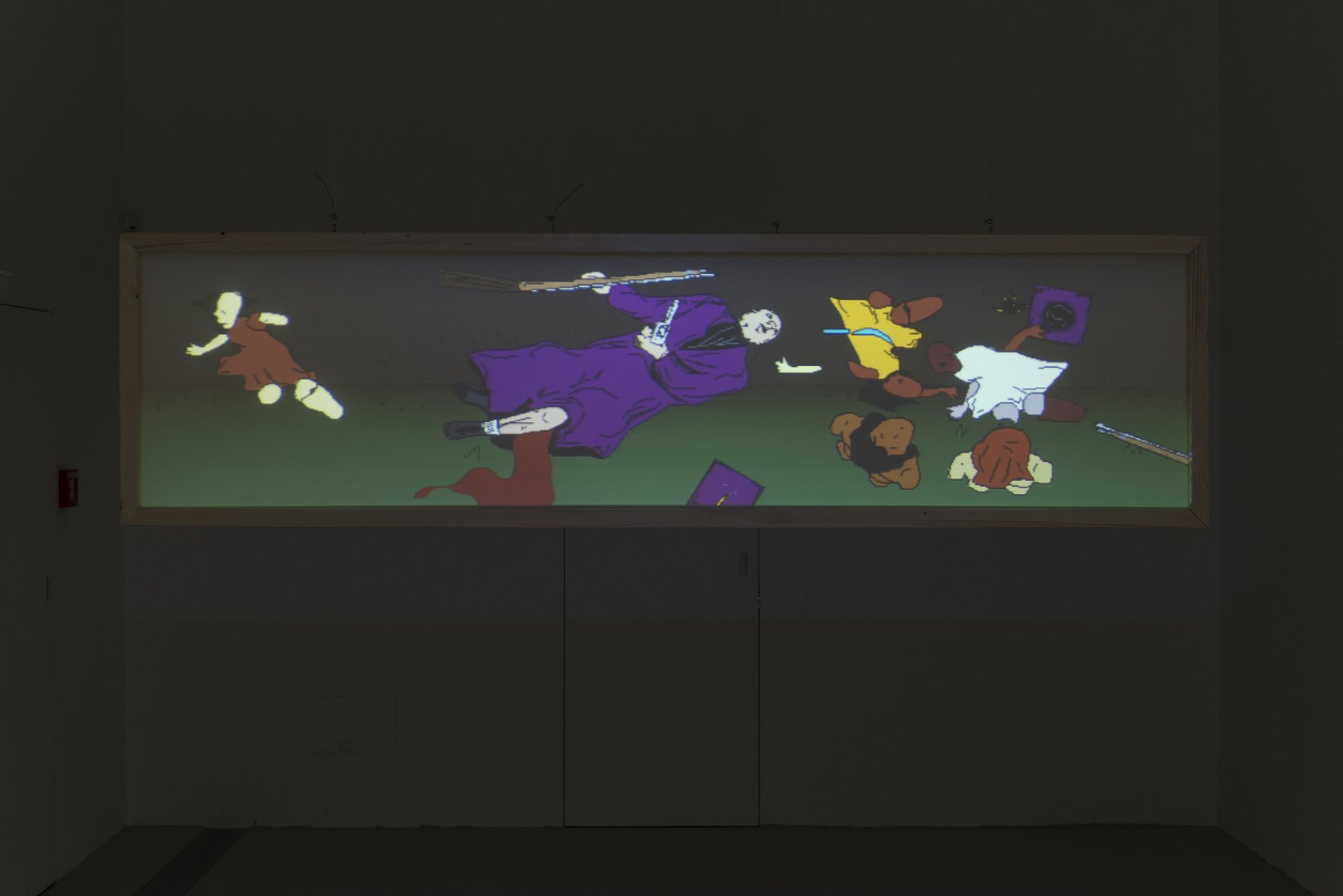
Paul Chan, Happiness (finally) after 35,000 Years of Civilization (after Henry Darger and Charles Fourier), 2000–2003
Digitally animated video, color, sound, 17:20 min. / Courtesy Julia Stoschek Collection, Düsseldorf
The works of the American artist, activist, author, and publisher Paul Chan (*1973 Hong Kong, lives in New York) address the relationship between politics and aesthetics, philosophy and popular culture as well as art and activism. His works often refer to topical political and social events in the USA. Happiness (finally) after 35,000 Years of Civilization (after Henry Darger and Charles Fourier (2000–2003) is one of his earliest works. The flash animation brings together the utopian ideas of the French social theorist Charles Fourier (1772–1837) with scenarios inspired by the imagery of the “outsider artist” Henry Darger (1892–1973). Darger is the author and illustrator of the 15.000-page Story of the Vivian Girls, who fight against a regime that enslaves children, whereas Fourier drafted the utopian idea of an ideal society, in which satisfaction of desire was portrayed as the ultimate aim of social organization. Whether Darger, the Chicago janitor, knew Fourier’s writing is unknown. By using an unusual format, Chan refersto the history of the panoramic view in art as well as to the marketing banners of the web 1.0.
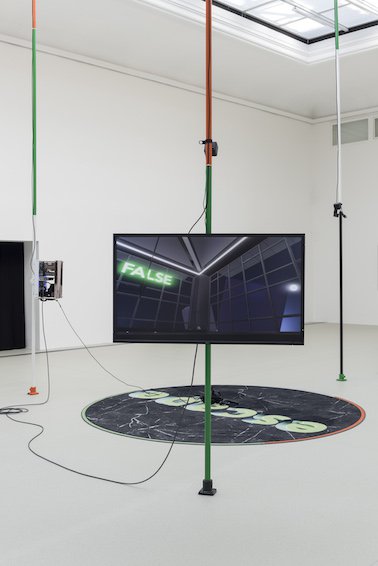
Banz & Bowinkel, Palo Alto, 2017
Powder coated aluminium tubes, 55” LCD monitor, HTC Vive VR, VR PC, custom printed carpet, 660 x 320 x 450 cm / Courtesy the artists / With thanks to Radiance VR The Platform for VR Art
Friedemann Banz (*1980 Mainz, lives in Berlin) and Giulia Bowinkel (*1983 Dusseldorf, lives in Berlin) focus in their artistic practice on the creation of virtual spaces in the digital age. Palo Alto (2017) is their second work that deals with forms of virtual reality. It examines the role of the computer as an everyday device and its influence on humans. Equipped with VR-glasses, the visitors can enter a labyrinthine plateau on which a tower is situated. After passing through an underground corridor, they reach a monumental pendulum that swings above their heads and points to either ‘true’ or ‘false’. In Palo Alto, the artist duo evokes a reality that, although it remains illusionist, can still be perceived as physically real and immersive with the help of the computer. Yet the virtual world is not depictedas a simulated reality, but it rather functions as its counterpart. Banz & Bowinkel question the concept of simulated reality and thus the human perception of the real and the virtual space.
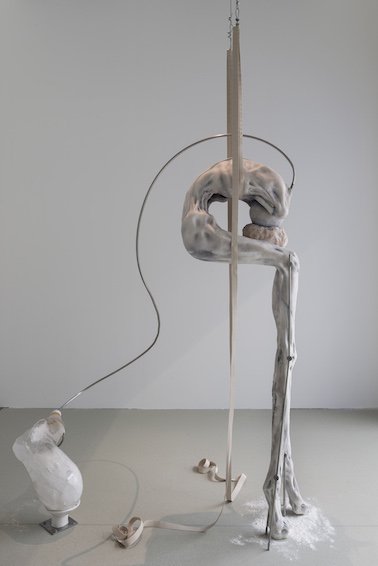
Ivana Bašić, Belay My Light, the Ground Is Gone, 2018
Wax, pink alabaster, breath, dust, weight, oil paint, pressure, stainless steel, ca. 140 x 230 x 250 cm
/ Courtesy the artist and Marlborough Contemporary, New York/London
In her sculptures and video works, Ivana Bašić (*1986 Belgrad, lives in New York) examines the fragility of the human body and the way it is altered and modified by time and technology. At times ghostly and disturbing, her works display a fragile corporality that evokes both admira tion and disgust; they oscillate between delicate beauty and repulsive vigour. In her sculptures, the artist fuses materials such as wax, glass or oil color, and deliberately includes pressure, weight or breath as material elements. With Belay My Light, the Ground Is Gone (2018), Bašić presents a body in the state of transition. Built from dust particles, it will gradually disintegrate and turn into dust again in a distant future. The video SOMA (Demo) (2017) is part of a larger project that the artist has been pursuing for some time. For its purpose, she had an avatar of her own body made that can be purchased onlinein a variety of versions. Bašić’s SOMA-project inspires the viewer to reflect on the availability of a body that is influenced by digital technologies.

Frauke Dannert, cut-out, 2018
Chroma key blue color, white wallpaint, 560 x 1530 x 600 cm / Commissioned by Künstlerhaus, Halle für Kunst & Medien / Courtesy the artist
Frauke Dannert’s (*1979 Herdecke, lives in Cologne) installations emerge through an analysis of the spatial conditions of the respective exhibition space, with a particular emphasis on the reflection of ist architectonic characteristics. Dannert’s connection with architecture stems from her early collages that she created by extracting buildings from architecture volumes and recombining them afterwards. In the following period, Dannert’s work shifted from the plane surface to the space; she used murals, intarsia carpets, and overhead projections to create walk-in environments and experiential spaces of abstract forms. For Artificial Paradise? Immersion in Space and Time, the artist varies the architectonic peculiarities of the Künstlerhaus, built in 1952, in a blue hue, commonly used in chroma key compositing for removing the background from a subject in film and TV productions. Subjects are filmed against a background consisting of a single color, usually blue or green, the so-called blue or green screen. The portions of the film which match this color can then be replaced by an alternate background.

Gerriet K. Sharma, mirage redux, 2018
Ambisonic sound sculpture, 15 min. and 5 min. of silence / Courtesy the artist / Supported by sonible GmbH
The sound artist and composer Gerriet K. Sharma (*1974 Cologne, lives in Graz) has been dealing with sculptural sound compositions in advanced 3D-audio-environments for 15 years. His work focuses especially on the theoretical and compositional discussion of space as “Spatial Practices.” With the sound sculpture mirage redux (2018), he establishes an aesthetic practice with an ambisonic sound projector (IKO) that composes a sound-space by adapting and integrating the architectural space as a prerequisite for sonic sculptural material. Thus, self-evident and other experiences at the border between technological disclosure and the subjective feeling of being surrounded are explored. By way of a reinterpretation of the formats, he intends to establish a distinction from ordinary media technology based sound environments, such as cinema, TV, or home 5.1. Over the course of the sculptural composition, the potential of the sound material, of the apparatus, and the structural surroundings is re-assessed, and thus the continuously problematic references to time, space, and body within a so-called (“virtual”) reality of the present are being investigated.
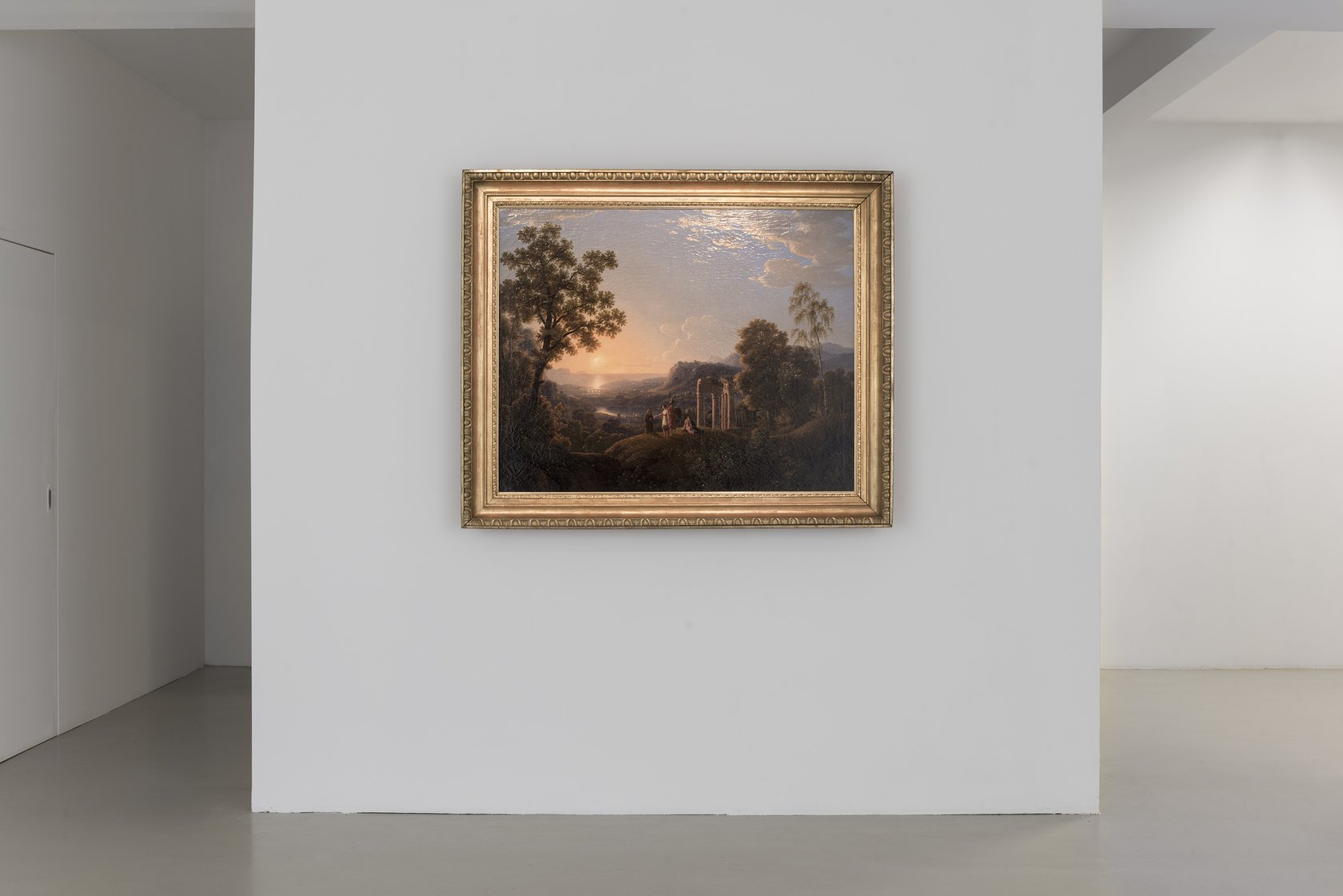
Johann Kniep, Ideale Landschaft mit untergehender Sonne, (Ideal Landscape with Setting Sun), 1806 / Oil on canvas, 95.5 x 121 cm / Courtesy Neue Galerie at the Universalmuseum Joanneum, Graz
Immersion in art is not a phenomenon of new media but has a long history. Already during the Renaissance, central perspective was used, for instance, in church painting, in order to generate threedimensionality, for effects such as the simulation of an open gateway to heaven inside the roof of the church. The landscape paintings created during Romanticism, however, were idealized images of nature and served as means for contemplation and immersion. The figures placed into those landscapes occasionally functioned as substitutes for the viewer and were a point of reference for “entering” the illusionistic space of the image. Johann Kniep’s (1779–1809 Vienna) Ideale Landschaft mit untergehender Sonne (1806), with a group of figures and remains of ancient architecture in its center, is composed to depict an Arcadian landscape. Already since early modern history, Arcadia had been known as a fantastic, idyllic place, and since the 17th century, in the context of pastoral poetry, it became the subject of aristocratic escapism. Kniep’s painting can be understood as an invitation to get lost in the fantasies of an idyllic existence in natural, unspoiled surroundings. By using bent image surfaces for the cyclorama or the panoramic painting, the immersive idea was subsequently developed further, and the viewers were thus literally incor porated into the respective imagery.
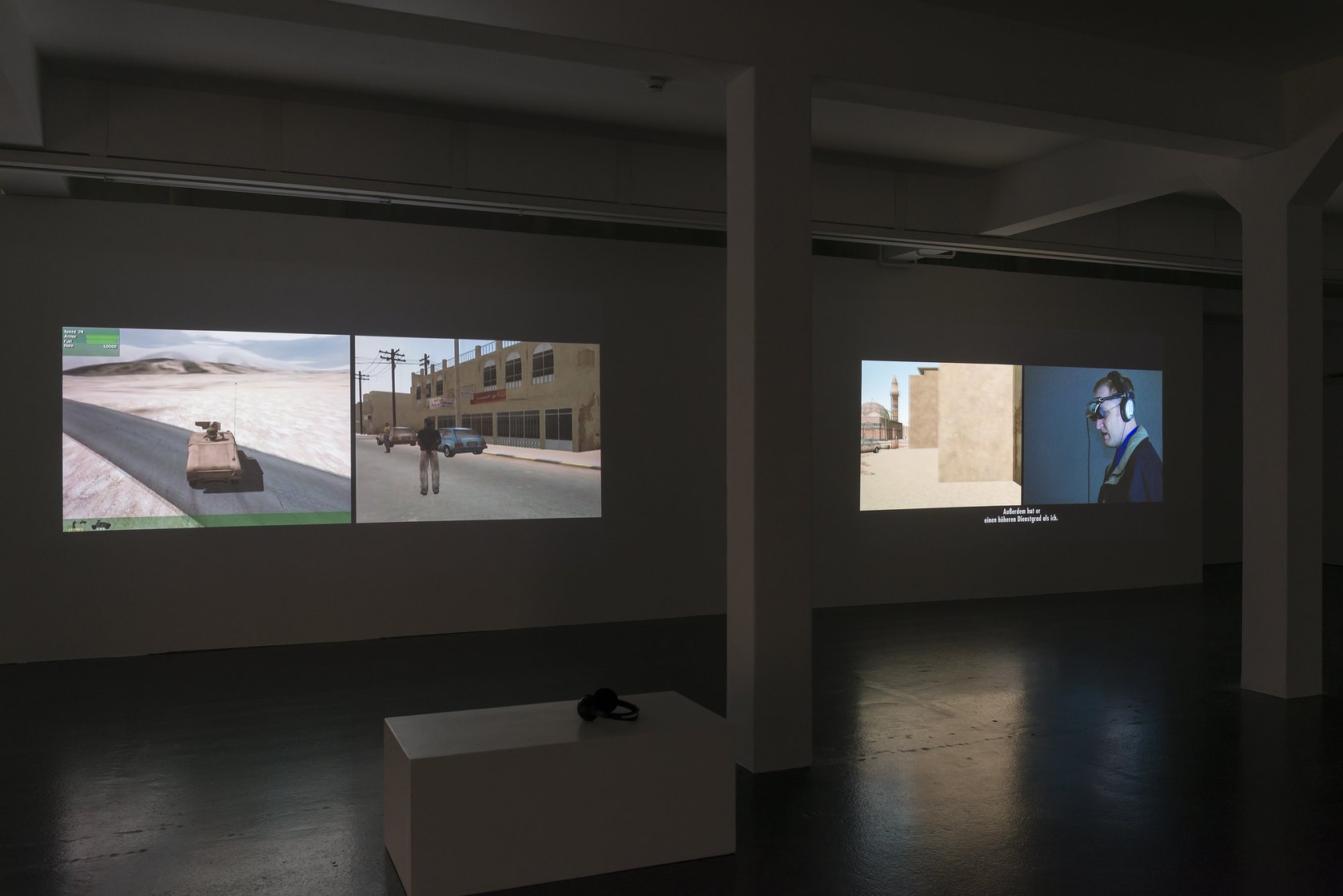
Harun Farocki, Serious Games I-IV: 2009-2010
Video installation, color, sound, 8 min./20 min. Courtesy Harun Farocki GbR, Berlin
Harun Farocki (*1944 Nový Jičín – 2014 near Berlin) was one of the politically most influential directors in Germany. His work, besides having socially analytical references, also questions the technologically made image, especially in regard to simulations and computer games. Already at a rather early stage, he addressed the discrepancy between factual and virtual reality. The four parts of his video installation Serious Games (2009– 2010), for instance, investigate the use of virtual reality in modern warfare. The first two parts are dedicated to a military drill simulation at the Marine Corps Base Twentynine Palms in California. In Watson Is Down (2010) four US-Marines prepare themselves for a potential war situation, by means of a precise virtual simulation of an Afghan landscape. Three Dead (2010) shows a military exercise with around 300 extras. The manoeuver was carried out in a town made from containers. According to Farocki, “it looked as though one had modelled reality on a computer animation.” For the third part, Immersion (2009), Farocki and his team filmed a workshop in Fort Lewis near Seattle, which dealt with imparting the use of “Virtual Iraq” to military therapists. With the help of this computer animation software, soldiers suffering from battlefield trauma should be given the opportunity to deal with their experiences by revisiting the traumatic event. The method was mainly taught and practiced through role play. In the final part, A Sun with No Shadow (2010), pictures that were used to prepare for war were juxtaposed with pictures used to evaluate war afterwards

Marc Lee, 10.000 Moving Cities – Same but Different (Mobile App), 2018
Mobile app as interface for an interactive, net based installation, dimensions variable / In collaboration with Antonio Zea, Florian Faion and Shervin Saremi / Courtesy the artist / Supported by Pro Helvetia, Swiss Arts Council
The Swiss artist Marc Lee (*1969 Knutwil, lives in Eglisau) creates network orientated, interactive projects in the field of media art. The work presented in Graz is a version of his installation 10.000 Moving Cities – Same but Different (2010), first shown in 2010/11 at the ZKM | Center for Art and Media Karlsruhe, now realized as a mobile app. In this work, well-known cities are recreated on the basis of the information posted about them on the social networks of the digital world, such as Flickr or Twitter. Visitors to the exhibition can navigate through the imagery from social media with a smartphone and experience the digital perception of the changes in these places in real time. From the immense amounts of data (from the Internet), only a manageable quantity of information is displayed, out of which a fragmented impression of the respective city arises. Marc Lee’s work deals with urbanization and globalization in the digital age and raises questions regarding change and assimilation in a globally interconnected world.
